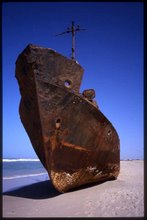Seven years ago, in Stockholm, I went to an art gallery.
A video was playing- a silent black and white documentary piece about an
abandoned man- made city off the coast of Japan. The beauty in the abandonment
and decay was palpable. I've been trying to find out more about the city ever since- but had no name, no information at all.Yesterday, dawdling through websites and google earth, with no particular place to go, I typed in "abandoned city" into the search box.
And my city of decay rises up.
The site belongs to the photographer Saiga Yuji.
He is really the first to document this extraordinary place and its transformation.
Gunkanjima was an island created for industry (coal) as well as housing its workers and thier families. There were temples and schools. Children rode their bicycles in industrial
back streets and played with dolls on the stairs of the workers housing. And then in 1973, it was closed down. Saiga Yugi was there when it happened, and he stayed until it was over.
Since then he has spent countless hours on the island. At night it is very strange.
Here are a few of his remarkable photographs.
Remember- this city was vital and living and real. People lived and quarreled and suffered and read books and stole things and dreamed and cooked and prayed and made love.
The island of Gunkanjima exists quite comfortably (or uncomfortably) in Mieveille's world.
























































